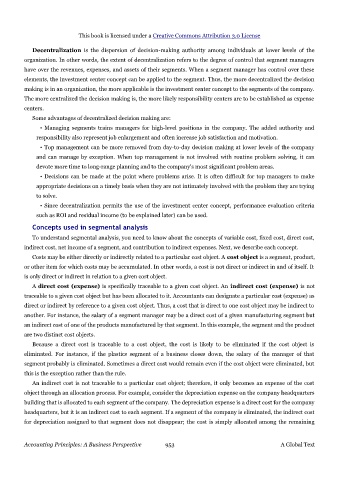Page 952 - Accounting Principles (A Business Perspective)
P. 952
This book is licensed under a Creative Commons Attribution 3.0 License
Decentralization is the dispersion of decision-making authority among individuals at lower levels of the
organization. In other words, the extent of decentralization refers to the degree of control that segment managers
have over the revenues, expenses, and assets of their segments. When a segment manager has control over these
elements, the investment center concept can be applied to the segment. Thus, the more decentralized the decision
making is in an organization, the more applicable is the investment center concept to the segments of the company.
The more centralized the decision making is, the more likely responsibility centers are to be established as expense
centers.
Some advantages of decentralized decision making are:
• Managing segments trains managers for high-level positions in the company. The added authority and
responsibility also represent job enlargement and often increase job satisfaction and motivation.
• Top management can be more removed from day-to-day decision making at lower levels of the company
and can manage by exception. When top management is not involved with routine problem solving, it can
devote more time to long-range planning and to the company's most significant problem areas.
• Decisions can be made at the point where problems arise. It is often difficult for top managers to make
appropriate decisions on a timely basis when they are not intimately involved with the problem they are trying
to solve.
• Since decentralization permits the use of the investment center concept, performance evaluation criteria
such as ROI and residual income (to be explained later) can be used.
Concepts used in segmental analysis
To understand segmental analysis, you need to know about the concepts of variable cost, fixed cost, direct cost,
indirect cost, net income of a segment, and contribution to indirect expenses. Next, we describe each concept.
Costs may be either directly or indirectly related to a particular cost object. A cost object is a segment, product,
or other item for which costs may be accumulated. In other words, a cost is not direct or indirect in and of itself. It
is only direct or indirect in relation to a given cost object.
A direct cost (expense) is specifically traceable to a given cost object. An indirect cost (expense) is not
traceable to a given cost object but has been allocated to it. Accountants can designate a particular cost (expense) as
direct or indirect by reference to a given cost object. Thus, a cost that is direct to one cost object may be indirect to
another. For instance, the salary of a segment manager may be a direct cost of a given manufacturing segment but
an indirect cost of one of the products manufactured by that segment. In this example, the segment and the product
are two distinct cost objects.
Because a direct cost is traceable to a cost object, the cost is likely to be eliminated if the cost object is
eliminated. For instance, if the plastics segment of a business closes down, the salary of the manager of that
segment probably is eliminated. Sometimes a direct cost would remain even if the cost object were eliminated, but
this is the exception rather than the rule.
An indirect cost is not traceable to a particular cost object; therefore, it only becomes an expense of the cost
object through an allocation process. For example, consider the depreciation expense on the company headquarters
building that is allocated to each segment of the company. The depreciation expense is a direct cost for the company
headquarters, but it is an indirect cost to each segment. If a segment of the company is eliminated, the indirect cost
for depreciation assigned to that segment does not disappear; the cost is simply allocated among the remaining
Accounting Principles: A Business Perspective 953 A Global Text

